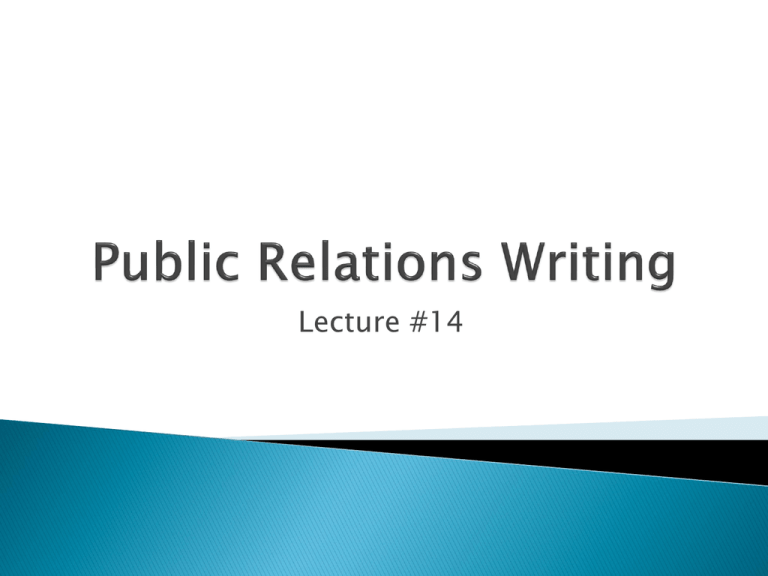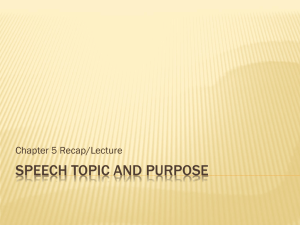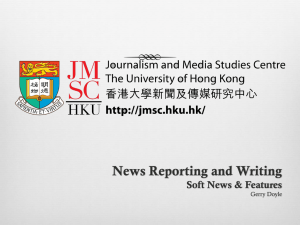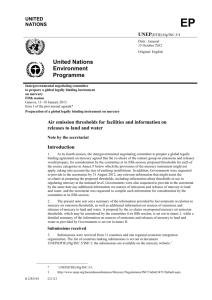View/Open - Cardinal Scholar
advertisement

Lecture #14 List 5 examples that a PR professional can use public relations writing. Even with the growth of the internet, public relations writing is still a critical part of this role. PR professionals are professional communicators, and often that means communicating through writing. PR professionals should write and speak better than any of their colleagues. The ability to write easily, quickly, and clearly is what classifies the role of PR professionals from others in an organization. Upper management often have finance, legal, engineering, or sales experience, but when they reach the top, it is important that they are able to write articles, speeches, memos, and testimony. They often need advisers, those being the PR professional. There are many PR professionals who are poor writers. Writing for the eye must be able to withstand the most rigorous scrutiny. Writing for the ear gives the audience the chance to only listen to the message and comprehend it. PR professionals must understand the difference between writing for the ear and writing for the eye. Writing takes patience and hard work. The writing must precede the expression: ◦ ◦ ◦ ◦ Must Must Must Must relate to the reader engage the readers attention concern the reader be in the reader’s interest It is key to come up with clever ideas, it isn’t always about inventing the wheel, but rather reinventing the wheel. Don’t be Afraid to Draft: the writer should produce a draft once there is an idea for a purpose to communicate– not matter how good an individual is at writing, it can usually use a second look. Simplify and Clarify: Simpler is better, use Standard English, avoid jargon and “in” words. Writing Must Be Aimed at a Particular Audience: the writer must have the target group in mind and construct messages accordingly. Rudolf Flesch believed that we should write just the way we talk. He thought that by doing so we write simpler. His seven suggestions for making writing more readable: Use contractions- it’s, doesn’t Leave out the word “that” as much as possible Use pronouns- I, we, they, you When referring back to a noun, repeat the noun or use a pronoun. Don’t create eloquent substitutions ◦ Use brief clear sentences ◦ Cover only one item per paragraph ◦ Use language the reader understands. ◦ ◦ ◦ ◦ Jim Ylisela- journalist and organizational writing instructor Believes you should make the words count ◦ Be specific: corporate writing is too vague ◦ Use more words: stretch your vocabulary ◦ Find better verbs: action oriented verbs drive sentences ◦ Pursue the active voice: PR writers should not use passive construction ◦ Omit needless words: cut words in a sentence by 10% Embrace simplicity and clarity: avoid big words and long sentences. Rid hype and corporate-speak. Tell a good story: use examples, illustrations, anecdotes, and personal experience to make points Find interesting voices: quote people who are interesting and say interesting things Take chances: go out and write the daring. Be original. Rewrite: everything can be improved. Form of a newspaper story. Climax is at the beginning. Tell the most important information at the beginning of the story and end with least important facts. Designed so that if the reader only reads the first paragraph they will know the key facts and what the story is about. The “lead” usually includes the who, what, when, where, why, occasionally how. The news release is the original vehicle for PR professionals. PR Newswire is a wire service used by professionals. Distribute over 1,000 news releases to 170 countries. The release may be written to document or state an organization’s official position. Used to influence a publication to write favorable about the material in the release. Most releases are not used word for word, but rather to intrigue an editor to consider covering a story. Reasons why releases aren’t used ◦ Releases are poorly written- complicated to read style that isn’t used in most news stories ◦ Releases are rarely localized- 10 times more likely to be used when localized ◦ Releases are not newsworthy- Based on impact (on community) Oddity (unusualness of the story). Conflict (a significant dispute or controversy) Known principle ( the greater the individual the great the chance of it being used- President, Governor, Mayor, etc.) Proximity (how localized the stories is) Also, Human interest stories Have a well-defined reason for the release. Focus on one central subject. Make certain the subject is newsworthy in the organization, industry, and community. Include facts about the product, service, or issue. Provide the facts without puffery. Don’t use jargon. Include appropriate quotes. Include product specifications- ship date, availability, and price. Include a brief description of the organization at the end of the release. Write clearly and concisely. A sloppy writing style can kill any great story ideas an organization might have. ◦ Capitalization- use caps sparingly ◦ Spelling- have a dictionary with you at all times ◦ Abbreviations- months when it is with a date, whole month then it is by itself or with a year, always write out the whole name of days of the week, use a whole name once and then abbreviate. Dec. 11, 2012, December 2012 Thursday, not Thurs Public Relations Society of America, then use PRSA Numbers- spell out zero through nine, use figures for 10 and up. Numerals are fine for times, percentages, speeds, election returns, heights, ages, sports, ratios. Punctuation- ◦ Colon: introduces listings, tabulations, and statements ◦ Coma: used before connecting words, between two words or sentences that may be misunderstood. ◦ Exclamation Point! Don’t use unless absolutely necessary. ◦ Hyphen: overused, can change the meaning of the sentence ◦ Quoted Material: enclosed in double or single quotation marks. The single marks are used for a quote inside a quote. Logo “Press Release”- For immediate release, includes a date. Headline- should be catchy Sub headline Lead Photo Cutline- states what the photo is up and any accreditation Copy- what the message actually is Website- may link to more info about what the release is sharing with audiences or could just be organization website About paragraph- short paragraph about the organization Contact- information for the person of contact AKA you, the PR person. PR professionals can now upload press releases online, completely avoiding the traditional method of contacting an editor and setting up an interview with a reporter. The vast majority of journalists today prefer to be contacted via email. Electronic Etiquette: ◦ Only put on reporter in the “To” line. This makes reporters feel like individuals, they want to feel special. ◦ Limit subject line headers- 4-6 words. ◦ Boldface “For Immediate Release”- Goes directly above the dateline. Since media is 24/7 releases to be used in the future are rarely accepted. ◦ Hammer the headlines- Boldface, upper and lowercase- 10 words or less. ◦ Limit Length- email releases should be shorter than print versions. Print-500 words, email shorter ◦ Observe 5W format- who, what, when, where, why…how ◦ No Attachments- NO ATTACHMENTS ◦ Link to the URL- use the link to the organization’s site ◦ Remember readability-short paragraphs, varied length, bullets, numbers, lists– they make the release more eye catching Writing for the eye emphasizes written word. ◦ Anything written- media, pitch letter, release, round-up article, backgrounder, op-ed, standby statement. Writing for the ear emphasizes spoken word. ◦ Anything Spoken- speeches, VNRs, ◦ Just as important today as writing for the eye. Media Kit: serves the purpose of introducing the organization to the media. ◦ Most include the following: The Biography: facts about the organization or individual. Straight Bio: lists facts in a straightforward fashion, most to least important, chronology of an individuals work/ history Narrative Bio: tells the story using the facts. Can also be a speech introduction Backgrounder Provides additional info. A company announces a new social responsibility initiative- backgrounder could provide previous SR work. Could also provide more general info about the organization Fact Sheets, Q&A’s, Photos: Fact Sheet- facts concerning product, issue, org., individual in a quick and easily accessible fashion Q&A’s- address the most likely questions from the media Photos- show the subject, should be in color. CD’s, DVD’s, speeches may be included– remember less is sometimes more Pitch Letter: used to interest an editor. Lets the reporter know about a possible story, interview, or event. It is best to be short and to the point. Creative- story like. Straight- more or less just says exactly what you want out of the reporter. Tell the reporter early what is in it for them. Always be respectful. Depending on your relationship with the reporter address them as Mr., Mrs., or Ms. Or you may be able to address them as “Bob,” “Mary” etc. Pitch Letters That Typically Sell: ◦ Open with a grabber, interesting statement the intrigues the reader. ◦ Explain why the story is relevant to the editors audiences. ◦ Should be written to a specific person. Round-up Article: ◦ Reporters get rewarded for two things: scoops and trends. ◦ Round-ups summarize the experiences of several organizations within an industry. The Case History: frequently used to tell about a customer’s favorable use of a product or service ◦ ◦ ◦ ◦ ◦ Present a problem They indicate the dimensions of the problem Indicate the solution Explain the advantages of the solution Detail the user company’s experience after adopting the solution Byliner- a story that is signed and authored by an officer of a particular firm. It is often ghost written by a PR professional Allows corporate spokespeople to express their views without being subject to major reinterpretation by the publication. Positions executives as experts. Use byliner reprints as direct-mail pieces to enhance their images. The Op-Ed: ◦ An editorial written by an organizational executive and then submitted to a major newspaper or magazine Grabber Point Chain of Evidence- facts that support the evidence Summation- summarizes the argument Good bye zinger- leaves the reader with something to think about Standby Statement: Used across the organization when answering to the media when an organization faces a tough situation. Usually are defensive. Not meant to be spoken about freely unless asked by media, consumers, stakeholders. Brief and unambiguous. Should have several standby statements ready. Used when: ◦ ◦ ◦ ◦ Price Increase Extraordinary losses Employee Layoffs Discrimination White Paper/ Position Paper: the facts or assumptions that lead to a particular position that the organization takes. ◦ Background- brief historical section that has brought the organization to its current state. ◦ Statement of the Challenge- simple and states the challenge that confronts the entity ◦ Alternative Solutions- briefly lists the pros and cons of the alternative ◦ Recommended Solution- states the solutions or position the organizations is taking. ◦ Blueprint and “key messages”- describes the next step for carrying out the proposed solution, then lists several key messages that will help reach the desired PR result. Audiences need to be persuaded. Two main public relations activities designed for the ear are speeches and presentations. Speeches- speechwriting has been one of the highest skilled tasks for PR professionals. Executives must defend their policies, justify their prices, and explain their practices. Speeches are: ◦ ◦ ◦ ◦ ◦ Designed to be heard, not read Uses concrete language Demands a positive thought Have objectives Tailored to a specific audience- must seem as though the speaker cares about the audience Preparation ◦ Who- who is speaking, who is the audience, to use humor, what manner? ◦ What- the subject/ topic OR the object to convince the audience to take a specific action ◦ Where- determine where the speech will take place, this could set the tone of the speech; casual or formal ◦ When- what time of day? You will have to determine how to grab the audiences attention. Interview: interview speakers in advance– can make a good speech bad if you don’t. Can be as little as five minutes before or a day before ◦ Determine the object of the talk ◦ Determine the speaker’s main points ◦ Capture the speaker’s characteristics Research- helps when you cannot put anything to paper ◦ Look at literature, books, pamphlets, articles, speeches, etc. to get ideas. ◦ Think about the subject- personal thoughts, emotions, nostalgia. ◦ Seek opinions of others- ask someone else about the topic if you are not a pro yourself. Organize your writing- it makes the speech more easier to write and more fluent. ◦ Introduction- grabs and holds the audience’s interests. ◦ Thesis- purpose or idea of the speech ◦ Body- evidence or what you want to say in the speech. ◦ Conclusion- do it quickly, restate key facts and the thesis. Presentation- Used often in professional sale, used to sell a product or service. ◦ Be organized- 4Ws. ◦ Get to the point- know the purpose and what you are trying to say. ◦ Be logical- organize your presentation so one thought leads to the next. ◦ Write it out- have the words in front of you in case you lose your train of thought. ◦ Anticipate negatives- there will be objections. ◦ Speak- don’t simply read from a Power Point, practice. ◦ Be careful of the use of graphics. ◦ Be convincing- enthusiastic, animated, interested ◦ Keep your presentation shorter, rather than longer- you will lose the interest of your audience. To be successful in PR you must be a good communicator, you must be able to convey what you mean to say both verbally and in writing. PR professionals are responsible for completing a wide variety of writing tasks. The press release is the most widely used PR media tool today for both print and electronic media. Writing must me clear and simple. Seitel, F.P. (2011). The Practice of Public Relations. Prentice Hall: Boston.











